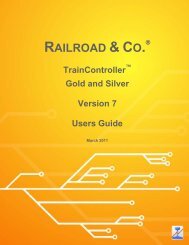Download - Freiwald Software
Download - Freiwald Software
Download - Freiwald Software
You also want an ePaper? Increase the reach of your titles
YUMPU automatically turns print PDFs into web optimized ePapers that Google loves.
B<br />
Push buttons and on-off switches not only can be used to operate a certain contact, but<br />
also to control other elements. It is possible, for example, to operate a group of related<br />
switches and signals with a single click to a push button. More details are outlined in<br />
section 12.3, “Operations”.<br />
62<br />
Connecting Signals and Accessories<br />
Signals and accessories are connected to their real counterpart on the model railroad<br />
much like the switches as outlined in section 2.4, “Connecting the Switches”. This is<br />
also done by selecting the symbol of the signal, or accessory, in the switchboard and using<br />
the Properties command of the Edit menu.<br />
For push buttons and on-off switches, which will be used to control other elements, a<br />
set of operations instead of a digital address needs to be specified. More details are outlined<br />
in section 12.3, “Operations”.<br />
2.6 Routes<br />
TrainController provides route elements, which are used to operate and lock the<br />
tracks, switches and signals, that belong to a certain route. Routes are represented in the<br />
switchboard by route symbols that are operated like an on-off switch. If the route is<br />
turned on, then all switches and signals of the route are operated. All track elements and<br />
signals along the path of the route remain locked in this position until the route element<br />
is turned off again. As long as these elements are locked, they cannot be operated or<br />
used by other routes.<br />
Manual Routes vs. Automatic Routes<br />
TrainController distinguishes between manual routes and automatic routes. Automatic<br />
routes can be operated automatically by the Visual Dispatcher. Manual routes can<br />
only be operated through their route symbol. They cannot be operated automatically by<br />
the Visual Dispatcher.<br />
A manual route is created by inserting a route symbol into a switchboard at an arbitrary<br />
location. The location of the route symbol in a switchboard does not matter. Especially<br />
the location of the route symbol must not relate to the location of the tracks, switches<br />
and signals contained in this route. Manual routes are created, if the Visual Dispatcher<br />
is not being used at all or for those areas of your layout, which are only controlled<br />
manually with switchboards but not with the Visual Dispatcher.










